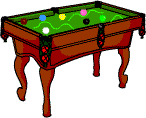Wave-Particle Duality
Created | Updated Jan 28, 2002

Around the 1900s physicists were feeling pleased with themselves. They figured they had pretty much got the whole physics thing worked out and they knew how everything worked.
For example, they had discovered electrons which they knew to be particles (like snooker balls), which they were quite chuffed with as it meant they could start developing television sets.
Just when everything was going fine for the physicists this bloke called de Broglie came along, and said: "Look you're wrong about these electron things, they're are definitely not like snooker balls, and are more like squiggly waves", and he reckoned he could prove it too. He got some electrons and got them moving really fast and then fired them through two tiny slits, which produced a pattern on a screen on the other side to prove (apparently) that electrons were definitely waves.
Now all the other physicists didn't like this much: I mean what sort of game could they play with squiggly waves? And someone would have to tell all the snooker players. So they told de Broglie he was wrong and they were definitely like snooker balls.
But de Broglie took out his really small slits and fast electrons and showed them the pattern, and they had to admit he'd got a point. So they went away and argued over who was going to tell the snooker players, but no one had the guts to do it.
Then some bright spark suggested that maybe that electrons could be both like snooker balls and squiggly waves, and would behave like which ever one you wanted them to. This was obviously complete rubbish, but at this point the physicists were getting pretty desperate and so agreed to it. As a result we ended up with the whole wave-particle duality theory.
It wasn't long after this that everyone realised that physicists had been wrong about quite a lot of other things. There is also a theory that later physicists just made up new ideas so they could make a living, which is still being hotly debated.

